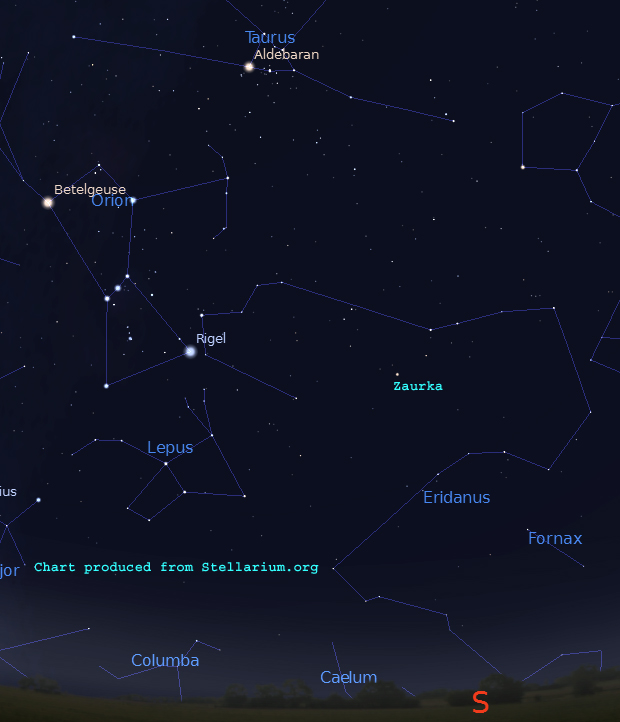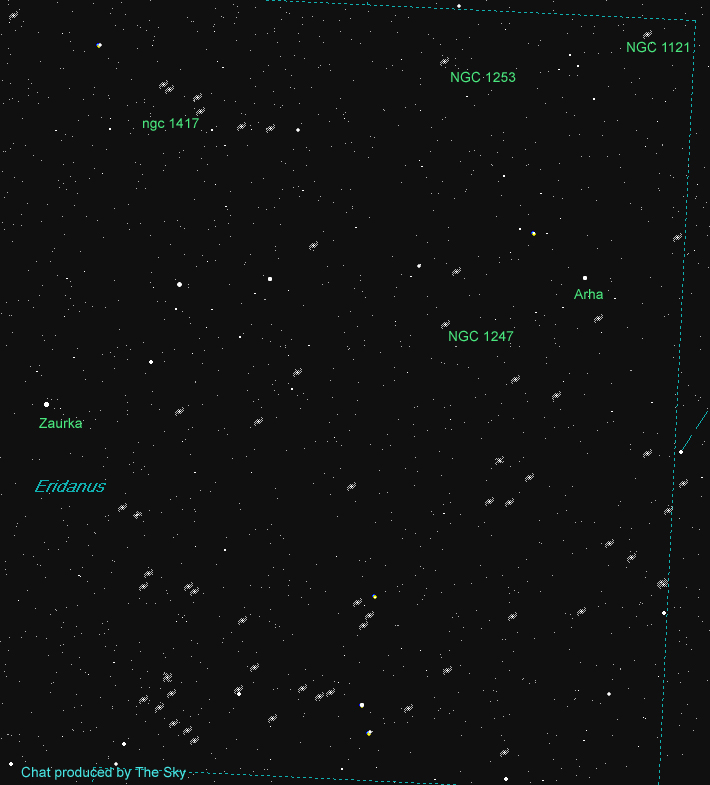The River Eridanus
Eridanus the River is a long but narrow constellation found at this time of year above the southern horizon or at least it's top half as seen from Canada. Starting close to the celestial equator, the entire asterism stretches down almost sixty degrees. Unlike the brilliant suns of the constellation Orion to the left, Eridanus lacks any bring stars and only range in brightness from magnitude 3.2 to 5.0 except for magnitude 2.9 Cursa. They are however unique in their individual life stories.
A case in point is the star named Azha shining at magnitude 3.9. With a luminosity of 67 times that of our Sun, Azha is a spectral K-type orangey coloured giant star that has stopped fusing its fuel of hydrogen and is swelling up to become a red giant. As the fusing process continues to heavier and heavier elements and Azha grows in size, it will begin to cast off its out layers and create a spectacular planetary nebula like the famous Ring Nebula. Azha is estimated to be 130 light-years away.
The stars that we see in the night sky are much hotter than a typical pizza oven and range from 54,000 degrees for the “O5” type stars down to 2,700 degrees for the “M8” type stars. Our Sun is a yellow G2 star that is pretty well the middle of the scale at 5,800 degrees. The hottest star in Eridanus is Lambda Eridani. Located an estimated 1,750 light-years from us Lambda shines as blue-white spectral B2 sun and is burning at 23,000 degrees. Its radius is thought to be 12 times that of our Sun and shines 39,000 times more brilliant.


The only planetary nebula visible is NGC 1535. Referred at Cleopatra’s Eye, the planetary seems to reside an estimated distance of 5,200 light-years and looks a lot like the famous Eskimo Nebula. The central star is difficult to observe visually. This stellar corpse is located four degrees east of Zaurak, a red giant M class star some 221 light-years from us. Visual observations of Zaurak will give you the impression of a double star system but this sun is a lone wolf and only appears a double by line of sight with another star.
Here are a couple of double stars to check out. 32 Eridani is made up of a magnitude 4.8 G8 yellow star and a 6.1 A1 blue star. This very close pair is only separated by 6.9 arc seconds. 32 Eridani is located at the top of the constellation border. Then we have 53 Eridani that consists of magnitude 3.9 and 6.9 companions with a challenging separation. 53 Eridani can be found six degrees east of the planetary nebula NGC 1535 referred to earlier.
There is a wealth of galaxies either in a single variety of groups. The nicest collection of a half a dozen within a two-degree field. The members are NGCs 1439, 1426, 1415, 1401 1395 and 1421. Only NGC 1439 and NGC 1426 are round elliptical galaxies, the rest are elongated in structure. They lie around the 100 million light-year range. Another trio of elongated beauties lies close to magnitude 4.1 Nu Eridani. Catalogued as NGCs 1618, 1622 and 1625, they are a bit farther at about 110 million light-years and are magnitude 13.5, 13.9 and 13.1 respectively.
The mighty planet Jupiter is now rising above the eastern horizon just before 10 p.m. locally at the beginning of the month and by a half-hour earlier each week afterwards. Throughout December has many fine transits of its moon across the Jovian surface, as well as its moons, can be seen. Refer to the RASC Observer’s Handbook 2014 page 236 for event times. Note these listings are listed in Universal Time and must be converted to your particular time zone. If you are still not sure if that bright object is the King of Planets, Jupiter is north of the waxing gibbous moon on December 11. The planet Venus, on the other hand, is very low in the western sky and is slowing climbing out of the solar glare and should be visible by the end of December.
C/2014 Q2 (Lovejoy) was discovered in August of this year is now down in the southern hemisphere but is heading north. It will swing closest by the Earth on January 7 where it comes within .469 astronomical units (au) from us and closest to the Sun on Jan 30, 2015, at a distance of 1.29 au. So you still have a few weeks to plan to observe and photograph it.
The Geminid meteor shower is the only meteor shower list for this month. This is the finest shower of the entire year that displays a good number of slow-moving meteors. Showers are usually produced by material cast off of comets as they round the Sun. In the case of the Geminids, asteroid 3200 Phaethon is the parent object. Clear your calendar for the show from the night of Dec 13 into the morning of the 14. Dress warm and head for dark country skies away from light pollution. This shower produces 120 meteors per hour moving at a mere 35 km/sec.
Winter Solstice begins on December 21 at 23:03 UT marking the first day of winter in the northern hemisphere and summer in the south. Solstice means Sun standstill. From here on the nights will begin to shorten up with longer days. The Full Cold Moon will occur at 12:07 UT on Dec 6 and the last new moon (lunation 11:38) for this year on Dec 22 at 1:36 UT.
Until next month, clear skies everyone.
